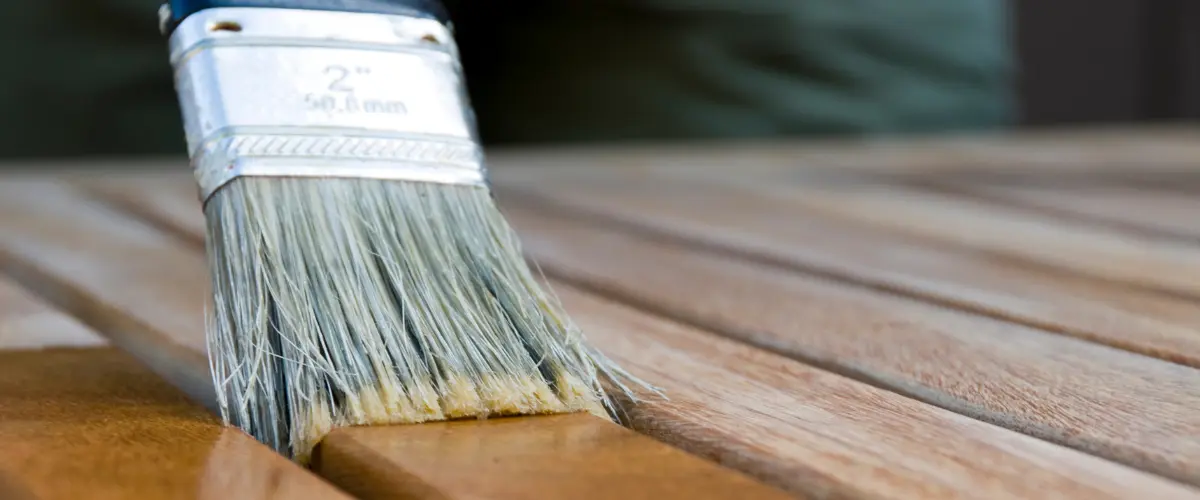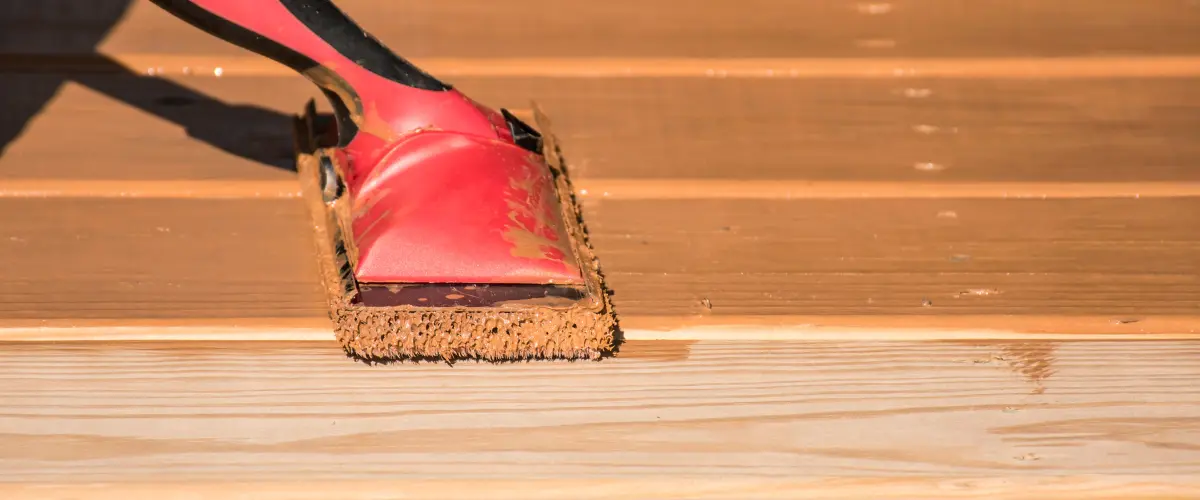Key Takeaways
- The perfect temperature for staining your deck is between 50°F and 90°F, with low to moderate humidity.
- Clean the deck and fix any damage like cracks or mildew before you start staining.
- Choose either oil-based or water-based stain depending on your deck's needs and weather conditions.
- Stain your deck in early spring or early fall when the weather is milder and less humid.
- Always apply stain in thin coats to ensure even drying and a beautiful finish.

Factors to Consider for Staining a Deck
Weather conditions (temperature, humidity, and rain)
Humidity also matters a lot; low to moderate humidity is ideal since high humidity can cause delays in drying time and may lead to a tacky finish. Rain is another critical factor – always check the weather report before starting your staining project.
You’ll need dry weather for two to three days after applying the stain to ensure it sets properly.
Keeping wood pores open for the stain to soak in means avoiding damp wood at all costs. Direct sunlight can make the deck surface hot, causing the stain to dry too quickly before it has had time to penetrate deeply into the wood.
Therefore, choosing a day with mild temperatures, low humidity, and no rain forecasted is crucial for achieving that perfect finish on your deck.

Deck condition
Check your deck’s condition before starting to stain. Look for signs of wear such as cracks, peeling, or mildew. These issues need fixing first. Cracks in the wood can expand if left untreated and lead to more significant problems down the line.
Peeling may indicate old stain or paint that hasn’t adhered well, requiring you to strip it off and start fresh. Mildew spots suggest moisture problems that could ruin new stains if not cleaned properly.
Use a deck cleaner on any dirt or debris stuck on the boards to ensure a smooth surface for staining. Dry wood absorbs stain better, so make sure your decking is completely dry after cleaning.
Waiting after washing allows the wood time to open up its pores, making it ready to accept stain more evenly for long-lasting protection against rain, snow, and sun damage.
Type of stain
After evaluating your deck’s condition, it’s essential to choose the right type of wood stain. There are several options available for homeowners aiming to protect and enhance their decks.
The two main types are oil-based and water-based stains. Oil-based stains penetrate deep into the wood, offering robust protection against moisture and wear. They’re ideal for decks that face harsh weather conditions or high foot traffic.
Water-based stains, on the other hand, dry faster and are easier to clean up with soap and water. They’re great for eco-conscious homeowners as they emit fewer volatile organic compounds (VOCs) than their oil-based counterparts.
Selecting between transparent, semi-transparent, solid, or semi-solid stains depends on your desired aesthetic and maintenance needs. Transparent stains showcase the natural beauty of your deck’s wood grain but require reapplying more frequently—usually every year or two.
Semi-transparent stains provide a hint of color while still allowing some wood grain to show through; they typically need reapplication every 2-3 years. Solid stains cover the wood grain but offer extensive color choices and longer protection, making them suitable for older decks that need a fresh look.
Semi-solid stains strike a balance between solid and semi-transparent offerings by obscuring most of the grain while emphasizing texture and providing durable coverage.
Proper preparation
Before applying deck stain, proper preparation is essential to ensure a successful outcome. Begin by checking the weather forecast for optimal conditions. Ensure that the surface of the deck is clean and dry, free from dirt, mildew, and previous coatings.
Sand any rough areas and apply a wood cleaner if necessary to ensure a smooth surface for staining. Using the right tools such as brushes or rollers designed for deck staining can help achieve an even application.
Lastly, select the appropriate type of stain based on your specific needs and preferences to protect your deck against changing weather.

The Best Time of Year to Stain a Deck
Spring
Spring is an ideal time to stain your deck, especially during late spring when the weather is warming up. With temperatures ranging between 50°F and 80°F, it’s perfect for applying deck stain as it dries more efficiently in these conditions.
The low humidity levels prevent moisture from being trapped in the wood, ensuring a smooth application process. It’s also a great opportunity to inspect the condition of your deck after the winter months and address any minor repairs before staining.
Early Fall
Transitioning from spring to early fall, homeowners should consider the favorable weather conditions for deck staining. In early fall, temperatures are typically milder, ranging around 50-70°F (10-21°C), which provides an ideal environment for stain application.
Moreover, lower humidity levels in early fall reduce the risk of moisture impacting the staining process and ensure that the wood is adequately dry for proper absorption of the stain.
Another benefit of staining your deck in early fall is avoiding extreme heat and direct sunlight. By doing so, you can prevent the stain from drying too quickly or unevenly. With these optimal conditions, homeowners can efficiently complete their deck staining projects during this time by taking advantage of the drier and cooler climate.
Avoiding high humidity
When staining your deck, it’s vital to steer clear of high humidity. Excessive moisture in the air can hinder the stain from adhering properly to the wood, resulting in a blotchy and uneven finish.
Elevated humidity can also prolong the drying period of the stain, leaving it vulnerable to gathering dust and debris before setting. To guarantee a successful staining process, monitor the weather for days with low humidity and schedule your project accordingly.
It is recommended to target a day with humidity levels of less than 50% for the best outcomes.

The Best Time of Day to Stain a Deck
Temperature considerations
When staining a deck, it’s crucial to pay attention to temperature. Aim for temperatures between 50°F and 90°F for optimal results with the stain. Staining in cooler temperatures can prolong drying time, while hot temperatures may cause the product to evaporate too quickly, leading to an uneven finish or bubbling.
Consider starting your staining project in the early morning or late afternoon when the sun is less intense and surfaces are not as hot. This will ensure that the stain has enough time to penetrate into the wood before drying too quickly.
Avoiding direct sunlight
When staining your deck, it’s crucial to avoid direct sunlight. High temperatures can cause the stain to dry too quickly, leading to an uneven finish and potential damage to the wood.
To prevent this, aim to stain your deck when it’s in the shade or during early morning or late afternoon when the sun is less intense. This will allow for better absorption of the stain into the wood and result in a more uniform and durable finish.
By ensuring that you apply the stain away from direct sunlight, you can optimize its effectiveness as it penetrates and protects your deck from wear and tear caused by weather conditions.
Staining in the morning vs. evening
For optimal results, consider staining your deck during the evening when temperatures are cooler. This allows the stain to dry more evenly and prevents it from drying too quickly, which can lead to an uneven finish.
Moreover, working in the shade during the evening helps to avoid direct sunlight, which can cause the stain to dry too fast and potentially result in lap marks or brush strokes on the surface.
When staining in the morning, ensure that you start early enough for the surface to fully dry before any potential dew forms. High humidity levels that often occur in the mornings can interfere with proper adhesion and drying of the stain.
Therefore, if choosing to stain in the morning, aim for a time when humidity is lower and temperatures are mild to achieve a flawless finish.
Tips for Successful Deck Staining
Checking the forecast
Before applying stain to your deck, it’s crucial to check the weather forecast for a dry period of at least 48 hours. Be mindful of rain and ensure that humidity levels are below 70%.
It is recommended to avoid staining on extremely cold or hot days, with the temperature ideally between 50°F and 90°F. When checking the forecast, aim for calm weather conditions without strong wind that could affect the staining process.
After reviewing the forecast, plan your staining project accordingly. Ensure there is no precipitation expected within two days following application to allow ample time for drying.
By monitoring these factors in the forecast, you can select the best window of opportunity to stain your deck successfully.
Properly prepping the surface
Before you start staining, it’s crucial to properly prep the deck surface. Begin by clearing the area of any furniture or plants and sweeping away debris. Use a wood cleaner to remove dirt, mold, and mildew.
For tougher stains, sanding may be necessary. Ensure the wood is completely dry before applying stain to achieve optimal results.
Using the right tools like a pressure washer or scrub brush will make cleaning more effective. Don’t forget to protect nearby plants and siding from potential damage during the prepping process for a smooth deck staining experience.
Using the right tools
For successful deck staining, select the appropriate tools for the task. Apply the stain evenly using a paintbrush or roller, or use a paint sprayer for larger decks. Clean and prepare the surface using a scrub brush or pressure washer to enhance the wood’s absorption of the stain.
It’s important to equip yourself with protective gear, including gloves, safety goggles, and a mask, to safeguard against any potential hazards from the stain’s chemicals.
Always choose high-quality tools suitable for outdoor use and durable enough for the job. Having all the essential tools on hand will facilitate your deck-staining project.
Choosing the right stain type
When choosing a stain type for your deck, consider the different options available such as oil-based, water-based, or solid stains. Oil-based stains penetrate deeply into the wood and provide a rich color, while water-based stains are eco-friendly and offer easy cleanup.
Solid stains create a protective layer on top of the wood, ideal for heavily weathered decks. Consider the level of protection and maintenance you desire when selecting the right stain type for your deck.
It’s important to note that understanding the characteristics of each stain type is crucial in making an informed decision about what will work best for your specific needs. In addition, considering factors such as UV protection, durability against foot traffic, and resistance to mold and mildew can help you narrow down which stain type is most suitable for your treated wood deck.

Top Manufacturers of Deck Stain
Behr
Known for its durable formulations, Behr offers a range of versatile stains suitable for various wood types.
Cabot
Cabot delivers exceptional moisture and UV protection with a rich selection of natural wood tones.
Olympic
Olympic provides long-lasting solutions designed to withstand harsh weather, protecting decks effectively while enhancing their beauty.
Rust-Oleum
A leader in home improvement products, Rust-Oleum offers innovative stains that combine easy application with excellent protective qualities.
Minwax
Popular for interior projects, Minwax also produces high-quality exterior stains that provide beautiful finishes and reliable protection.

Best Weather To Stain a Deck - FAQs
Conclusion
With years of experience in deck staining, our team consists of highly skilled professionals dedicated to delivering exceptional results. We’ll make your deck building or deck installation project a success!
If you’re ready to get your new deck-related project started, we’re at your service in Omaha, Papillion, Bellevue, Gretna, Elkhorn, and more of Nebraska! Call us today at (402) 369-5724 or request a quote and let’s talk!
